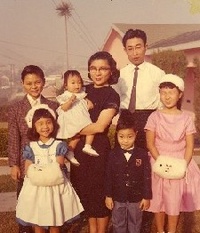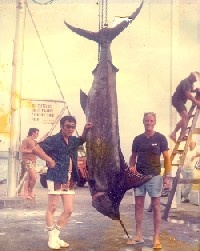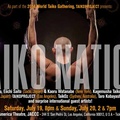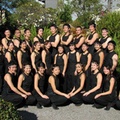Being a cultural anthropology major, I enjoy studying culture, and I wanted the chance to learn more about my own. So, in May of 2007, I applied to be a part of the Nikkei Community Internship Program. This is a state-wide program based at the Little Tokyo Service Center in Los Angeles and the Japanese Community Youth Council in San Francisco. Through this program, I was placed at the Japanese American National Museum. It was a perfect match. I was placed at the core of Japanese American culture, the place where artifacts, documents and histories of the Japanese Americans experience are preserved. I was initially terrified when I found out I’d be working on a website, the museum’s very own DiscoverNikkei.org. However, I was reassured that I would be working with content in the Nikkei Album, not programming. Whew! The program began with an opening retreat, where all of the interns were able to get to know the Little Tokyo area. Our first stop was the Japanese American National Museum.
I walked into the Museum on June 24, 2007 and saw Frank Kikuchi, a docent of the Museum, walking toward me. I was with the rest of the NCI program interns, and we were scheduled for a tour of the Common Ground: The Heart of Community exhibition. Frank was our tour guide.
I couldn’t have asked for a better explanation of the exhibition. Not only was the information factual, historical and accurate, but Frank knew how to add the magic touch, himself. Frank was among those incarcerated at Manzanar during World War II, and he made certain that we heard his personal story. He had a personal anecdote to accompany almost every item or picture we stopped to look at. I found this absolutely fascinating. He actually made three of the girls in the group cry.
I knew that I wanted to see Frank again, to talk to him more about his experiences and to learn from him. However, I soon became totally engrossed in my internship project, creating Nikkei Albums for the Discover Nikkei website, that I almost forgot about wanting to meet Frank. I had this urge to get as much done as I could in the little time that I had at the Museum. I became fascinated with the idea of telling stories and histories through Nikkei Album. Then, I remembered Frank, and a whole new world of ideas presented themselves! After a bit of guidance and encouragement from the project staff, I decided I would create a Nikkei Album all about Frank’s life. I sought him out, presented the idea, and soon, we had a date!
The interview was twice as intense as the tour, twice as emotional. He told me stories about his entire life, starting with his parents’ migration and ending with his current position and duties as a docent.
Frank was born in Seattle, Washington to two Issei parents, one from Fukuoka, the other from Iwate. He grew up in a primarily Japanese American community, and his family was well off. Frank said that his father owned some apartment buildings at one point, and that they had a new car every other year. Frank moved to Utah when his father invested in a coalmine there. After a year in Utah, the Kikuchi family moved out to Los Angeles, where Frank’s father started a grocery store. Frank attended Maryknoll School and Cathedral High School in Los Angeles. He had finished all of his senior year final exams at Cathedral and was simply waiting for graduation. Instead of graduating, however, Frank went to Manzanar. He never received his diploma.
Frank lived on Block 20 at Manzanar, along with Toyo Miyatake and his family, Sue Kunitomi, and his best friend, Hikoji Takeuchi. Toyo Miyatake had a well-known photography studio, Toyo Miyatake Studios, that is still in existence today. Toyo’s son, Archie Miyatake, and Frank were good friends at Manzanar, and remain friends today. Frank also knew Sue Kunitomi, the woman who founded the Manzanar Pilgrimmage Program. His best friend, Hikoji Takeuchi, was shot in the arm by a sentry, because he went outside of the barbed wire gate to gather firewood. The unfair part was, the sentry gave him permission to do so, and was watching him the entire time. Hikoji had to return to Japan after World War II, and Frank did not see him again until 2004, at a funeral. Frank recognized him right away. These are some of the stories of hardship and misfortune that Frank discussed that day.
After talking for a bit, Frank showed me some pictures that he had brought. Just like each photograph and artifact in the Common Ground exhibition had a story, each of Frank’s personal photos prompted a story as well. These pictures were of his friends, his family, his hobbies, and his interests. He showed me pictures of Ralph Lazo, who Frank knew through his wife, Tama. Ralph was a young man of Mexican-Irish descent who volunteered to go to Manzanar to endure the injustices with his Japanese American friends.
Just like any proud father and husband, Frank really enjoyed talking about his family. While looking at pictures of his family, I could tell that he absolutely adored his wife, who passed away just three years ago. He made sure that I knew where each of his five children went to school, and what they do now. All of his children went to Maryknoll School and Cathedral High School, just like Frank did. Tom, his eldest, attended UCLA, and now has a custom model supply store. David, his other son, attended California State University, and now has two children. Joyce, his eldest daughter, attended USC, and now is a dental hygienist. She also teaches at USC and Pasadena City College. Linda, another of Frank’s daughters, also went to USC, and she now has three children, who she spends all her time raising. Susan, his youngest, attended Business School, and she is now an executive with Lakeshore, a children’s educational supply store business. Although they have all started their own families and established their own homes, Frank loves spending time with his children when they come and visit him.
When Frank isn’t busy giving tours at the Museum, he goes fishing. Frank loves to fish. Once, he went on a fishing trip with a group of men he had never met, simply because he wanted to fish. He’s traveled to Alaska several times, and I got to see many photos of him with the fish he caught. Frank once caught a giant marlin in Hawaii. It must have been at least 10 feet long. The photograph is amazing.
I did much more than just learn more about my culture this summer. I learned how to appreciate the value of somebody’s story. It is because of people like Frank that I believe in the power of personal stories. It is because of stories like Frank’s that I believe in the importance of and see the significance in preserving history. I know everybody has a story to tell, no matter how big or small, no matter how good or bad. From others’ experiences, thoughts and feelings, we can learn, and we can prevent negative events, such as the Japanese American incarceration during World War II, from happening again. Most importantly, we can grow.
It wasn’t a coincidence that Frank was my tour guide that day. He served as a catalyst for my deep desire to continue to capture and preserve stories through Nikkei Album. I encourage everyone of my generation to pair up with your grandparents and parents, and get their stories. Share their stories. Teach each other. Help each other grow.
>> To view the Frank Kikuchi Nikkei Album Collection, click here.
© 2007 Elizabeth Ishida







